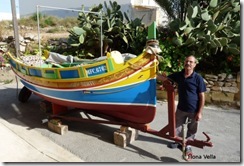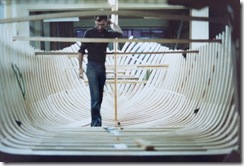Posts Tagged ‘Victoria’
-
Guests to history
One would probably spare only a few moments of consideration at the receipt of a wedding invitation. However, for Baron Igino de Piro d’Amico Inguanez, these endearing solicitations were cherished so much that he kept a collection of them, neatly separated according to their date and wrapped up together by a string.
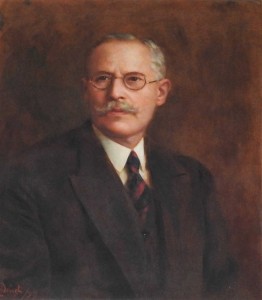 “Were it not for my grandfather’s interest to keep these wedding invitations, we would have lost this fascinating information which can be unravelled within each one of them,” remarked Marquis Nicholas de Piro as we walked towards an elegant table in one of the rooms at Casa Rocca Piccola where he had layed out a number of these invitations.
“Were it not for my grandfather’s interest to keep these wedding invitations, we would have lost this fascinating information which can be unravelled within each one of them,” remarked Marquis Nicholas de Piro as we walked towards an elegant table in one of the rooms at Casa Rocca Piccola where he had layed out a number of these invitations.I glanced out at the wide selection of wedding invitations tastefully set on the polished wooden surface, noticing the different sizes, shapes, writing, designs and paper. The earliest ones dated back to 1815, 1829 and 1832. They were quite plain and small, slightly bigger than a credit card, and written in Italian.
“Here are two of the prettiest ones” said the Marquis as he pulled them out of the rest.
These two invitations had been issued at the end of the 19th century. They were larger than the earlier ones and were quite different from each other. The one dated June 1896 was elegantly designed with an intricate cross at its corner and consisted of an invitation to the wedding between the noble Maria de Piro and Dr. Alfredo Stilon. The other one dated October 1899 was more colourful and rather than an invitation, it was more an announcement of the wedding which was to take place between the noble Maria Teresa de Piro and the Marquis Paolo Apap Bologna. Once again, both were written in Italian.
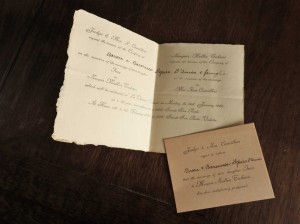 “Now look at this note which accompanies this wedding invitation,” said the Marquis as he handed it to me.
“Now look at this note which accompanies this wedding invitation,” said the Marquis as he handed it to me.The presentation of this wedding invitation was simpler than the previous two and the writing was in English. Here, Judge and Mrs L Camilleri were requesting the company of Baron and Baroness I de Piro d’Amico Inguanez and family to the wedding of their noble daughter Inez to Marquis Mallia Tabone on 26th January 1920. Yet this celebration was not destined to take place as a smaller card which was sent some days later informed those invited that this wedding had been indefinitely postponed.
 “From these invitations, one can also observe the traditional customs of the various eras. For example, this wedding invitation dated 1935 shows clearly that people who chose to get married during the period of Lent had to abide to some limitations.”
“From these invitations, one can also observe the traditional customs of the various eras. For example, this wedding invitation dated 1935 shows clearly that people who chose to get married during the period of Lent had to abide to some limitations.”Indeed, a formal note which was inserted together with the wedding invitation that was sent by Chev & Mrs E Moore and Mrs H Xuereb to announce the marriage of their daughter Alice Moore to Godfrey Xuereb, provided this information with direct instructions:
‘It is much regretted that in view of the restrictions imposed by Canon Law for weddings held in Lent, only a few guests may attend the religious ceremony at the Archbishop’s Palace.
You are therefore invited to meet the bride and bridegroom immediately after the ceremony at the residence at 4:00pm.’
 As we followed the different invitations that were sent along the years to Baron Igino and his family, we could also trace some of his friends and acquaintances, their residences, the chapels and churches where the marriages took place, and the selected locations for the wedding receptions. Although many of the churches still exist today, some of the street names had changed from Italian to English or were altered completely. A number of the residences mentioned have become quite renowned today whilst a few others were turned into commercial properties. Sadly, some of the lovely villas which provided exquisite entertainment in the bygone days were demolished to make place for large modern complexes.
As we followed the different invitations that were sent along the years to Baron Igino and his family, we could also trace some of his friends and acquaintances, their residences, the chapels and churches where the marriages took place, and the selected locations for the wedding receptions. Although many of the churches still exist today, some of the street names had changed from Italian to English or were altered completely. A number of the residences mentioned have become quite renowned today whilst a few others were turned into commercial properties. Sadly, some of the lovely villas which provided exquisite entertainment in the bygone days were demolished to make place for large modern complexes.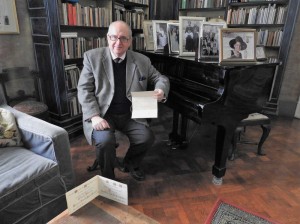 Amongst these, there was the wedding between Hilda Scicluna and Paymaster Lieutenant W Eric Brockman that took place on 4th March 1928. Their marriage was celebrated at the Archbishop’s Palace in Valletta which seems to have been quite a popular venue for such occasions. On the other hand, the reception was held at the bride’s parents residence that was located at 86 Strada Merkanti Valletta; a house which originally belonged to Sir Oliver Starkey, Bali of Aquila and Latin Secretary to Grand Master La Valette. Being an English Knight, he had assisted the Grand Master during the Great Siege of 1565 and was later given the privilege to be buried in the crypt of the Co-Cathedral of St John in Valletta, close to La Valette’s own burial place.
Amongst these, there was the wedding between Hilda Scicluna and Paymaster Lieutenant W Eric Brockman that took place on 4th March 1928. Their marriage was celebrated at the Archbishop’s Palace in Valletta which seems to have been quite a popular venue for such occasions. On the other hand, the reception was held at the bride’s parents residence that was located at 86 Strada Merkanti Valletta; a house which originally belonged to Sir Oliver Starkey, Bali of Aquila and Latin Secretary to Grand Master La Valette. Being an English Knight, he had assisted the Grand Master during the Great Siege of 1565 and was later given the privilege to be buried in the crypt of the Co-Cathedral of St John in Valletta, close to La Valette’s own burial place.The Cathedral in Mdina seems to have been another prominent place for marriages. On 24th January 1937, Adelina Maempel was married to Edwin England Sant Fournier. A reception followed at Villa Luginsland in 26 Boschetto Road, Rabat; a lovely villa which was built by Baron Max von Tucker, the German consul who was serving in Malta in the early 20th century. Unfortunately in recent years years, this remarkable place was in an abandoned state and had a haunting atmosphere.
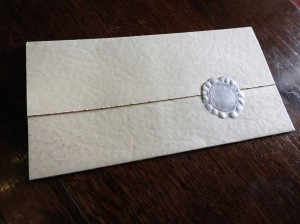 The only wedding invitation which came from Gozo looked quite distinguished and it boasted a silver wax seal. The marriage of Carmela and Paul Vella took place on 4th August 1937 and their reception was organized at the Duke of Ediburgh Hotel in Victoria, Gozo. Alas, in recent years, this splendid hotel that was beautifully constructed in Victorian architecture was demolished in order to make way for a commercial centre and a number of residential units.
The only wedding invitation which came from Gozo looked quite distinguished and it boasted a silver wax seal. The marriage of Carmela and Paul Vella took place on 4th August 1937 and their reception was organized at the Duke of Ediburgh Hotel in Victoria, Gozo. Alas, in recent years, this splendid hotel that was beautifully constructed in Victorian architecture was demolished in order to make way for a commercial centre and a number of residential units.“As you have already noted, some of these wedding invitations pertained to our relatives. Incidentally, this one which announces the marriage between my aunt Mona de Piro to Major John E J Nelson on 28th December 1940 is a favourite of mine, particularly because she was quite a character and she kept her high spirits even when she was aged more than ninety. Well, she’s there, looking at us!” the Marquis exclaimed as he pointed to a delightful portrait on the opposite wall.
My eyes met with those of a young, graceful girl, defiantly posing with an off-the-shoulder silver dress which melted in the greyish background behind her.
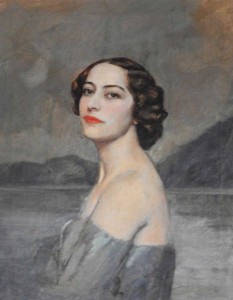 “That portrait created much talk when her relatives saw it since it was regarded too sensual at the time. It was commissioned by her Italian boyfriend, Marquis Onofrio Bartolini Salinbeni, and the painting was done by Arthur Acton who lived in a palace in Florence. Onofrio was madly in love with Mona but unfortunately, their relationship ended and when she returned to Malta, a relative of hers went to Italy to claim this painting since it was not deemed fit for him to keep it,” smiled the Marquis as he went to add some logs to the fire burning in the stylish hearth besides us.
“That portrait created much talk when her relatives saw it since it was regarded too sensual at the time. It was commissioned by her Italian boyfriend, Marquis Onofrio Bartolini Salinbeni, and the painting was done by Arthur Acton who lived in a palace in Florence. Onofrio was madly in love with Mona but unfortunately, their relationship ended and when she returned to Malta, a relative of hers went to Italy to claim this painting since it was not deemed fit for him to keep it,” smiled the Marquis as he went to add some logs to the fire burning in the stylish hearth besides us.A warm gush of air embraced the room as the logs protested and cracked and poured a glowing light over the wedding invitations lying in front of us. For a short spell, I thought that I could hear the tinkling of the glasses filled with red velvety wine and golden sizzling champagne as the guests toasted to the newly married couples.
(This article was published in the Weddings Supplement issued with The Sunday Times of Malta dated 13th March 2016)
-
IN SICKNESS AND IN WEALTH
Although today, many societies relate marriage to two persons falling in love with each other, in the past, matters were quite different. Some of the local marriages, especially in wealthy families, were pre-arranged at age seven, in order to ensure that the children will marry a partner at par or even one which could enhance their title and possessions.
Parents were expected to provide their daughters with a dowry as a form of marriage payment and at times, as a kind of anticipated inheritance. Generally depending on the couples’ status and on the type of marriage contract which they adopted, this dowry could either serve to assist the newly-wed to establish a new household, or else to act as a mode of protection against the possibility of ill treatment to the bride by her husband and his family, since in the latter cases, the dowry might have to be returned back. A dowry offered also an element of financial security in widowhood, particularly if there were little children in the family.
The Notarial Archives in Valletta possess a treasure trove of stories connected to marriages and dowries of the past. Thick manuscripts with remarkably detailed records of people who lived hundreds of years ago, encapsulate these significant moments in the elegant writing in black ink and brings them back to life, each time someone opens the old pages and reads.
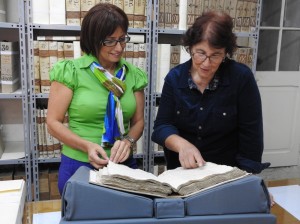 “One of the earliest contracts of marriages which one can find at these archives is dated to 1467. In it, Zullus Calleja from Naxxar is listing the objects which he is forwarding to the groom as a dowry in name of his daughter Jacoba. The form of this dowry is alla Maltese, and that means that the future husband will only be able to administer these possessions but not to sell them without his wife’s consent. However, once their children are born, this dowry will automatically be divided into three equal parts; one belonging to the husband, the other to the wife, and the rest to the offspring. Nevertheless, the children will not be able to utilize these belongings until they reach age 15,” revealed historian Dr Joan Abela.
“One of the earliest contracts of marriages which one can find at these archives is dated to 1467. In it, Zullus Calleja from Naxxar is listing the objects which he is forwarding to the groom as a dowry in name of his daughter Jacoba. The form of this dowry is alla Maltese, and that means that the future husband will only be able to administer these possessions but not to sell them without his wife’s consent. However, once their children are born, this dowry will automatically be divided into three equal parts; one belonging to the husband, the other to the wife, and the rest to the offspring. Nevertheless, the children will not be able to utilize these belongings until they reach age 15,” revealed historian Dr Joan Abela.Together with Isabelle Camilleri, a diligent worker at the Notarial Archives, Abela prepared a display of manuscripts pertaining to different eras so that I could analyze the interesting data within.
“Whilst I was doing some research about marriage contracts in the old days, I discovered that much of them included also a section marked as dos which related to the dowry being given by the father to the groom. Some of these dowries formed part of the inheritance of the bride and therefore it was declared in the contract that the amount which was being given to her during marriage, would be eventually decreased once she inherits her deceased parents. On the other hand, some contracts stated that this dowry was being donated over and above the future inheritance that the woman will have,” explained Abela.
This study shed light also on different types of dowry contracts which were in existence at the same time during various periods.
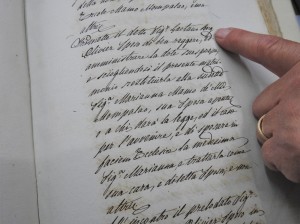 “The most popular ones were the contracts that used the alla Greca or the alla Romana custom, which were practically the same thing. Basically, this type of contract stipulated that all the dowry which was forwarded by the bride’s father to the groom could only be administered by the latter but it could never be alienated without his partner’s approval.”
“The most popular ones were the contracts that used the alla Greca or the alla Romana custom, which were practically the same thing. Basically, this type of contract stipulated that all the dowry which was forwarded by the bride’s father to the groom could only be administered by the latter but it could never be alienated without his partner’s approval.”No matter which style was chosen, all these dowry contracts were quite formal and organized. Experts in each sector of the items being included in the dowry were called upon to evaluate these objects professionally, and their names were included in the contract as a guarantee of genuinity. Ultimately, each of these things were described meticulously in the contract, together with their value at the time.
“Each time that I am working on a new manuscript, I am often delighted at the descriptions that I find. They are so rich in detail that I get the impression of seeing or touching the materials being mentioned, or of smelling the scents and perfumes of the objects in question. I find myself literally in another world as I delve through these pages and read the lists of things that this bride carried with her to her new home,” Camilleri said.
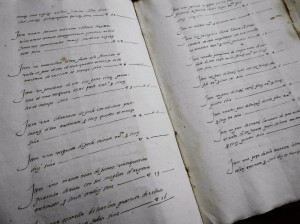 Dowries of affluent people could be quite impressive. One of these which was in the alla Romana style, had a list of more than 60 objects and was dated to 1557.
Dowries of affluent people could be quite impressive. One of these which was in the alla Romana style, had a list of more than 60 objects and was dated to 1557.“There is so much to ponder in this contract,” remarked Abela. “The one who was making the dowry was the renowned knight Marshall Fra Guglielmo Couppier who took part in the Great Siege of Malta in 1565. Interestingly, Victoria, the bride, had been Couppier’s slave but he had given her freedom. Moreover, in this contract, he was also forwarding a substantial dowry in her name, worth of a highly noble woman, to her future husband Hieronomu Debonè who worked as a bombardier and blacksmith.”
Victoria’s dowry included a 20 year old black male slave and a 59 year old female slave, refined jewelry made of gold, precious stones and pearls, clothes made from the most costly materials such as silk, velvet and wool, and mattresses, pillows, bedsheets and blankets of the finest luxury.
“Another type of dowry contract that was available was known as alla Latina. I didn’t find many of these and I noticed that generally they were used by peasants or families who were not so well-off. In fact, the main aim of such contracts was to help the couple initiate a new life together, since otherwise, this would have been difficult. The agreement in such contracts stated that after a year from their wedding, whatever the couple owned, including the dowry which the bride had brought with her, would belong to both of them. And once children were born, these possessions would be divided into three equal parts between the husband, wife and offsprings.”
Unlike the other types of dowry contracts wherein the husband was bound to return all the dowry objects to his wife’s father, in the same good state, or even better, should their marriage fail for any reason or if the woman died before having any children, the couple which chose the alla Latina contract shared both the good and bad times together.
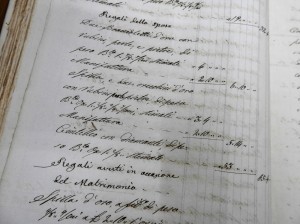 Camilleri led me to another manuscript which dated to the 1860 wherein she showed me a long contract that incorporated an inventory of the dowry of a woman who had died and left three small children behind. Her husband was going to get married a second time and so it was required to specify exactly the origin and value of the deceased wife’s possessions.
Camilleri led me to another manuscript which dated to the 1860 wherein she showed me a long contract that incorporated an inventory of the dowry of a woman who had died and left three small children behind. Her husband was going to get married a second time and so it was required to specify exactly the origin and value of the deceased wife’s possessions.“This dowry included also the gifts which she was given during her wedding,” highlighted Camilleri. “Jewelery made the best part of it and it comprised items made of gold, precious stones, pearls and diamonds. Who gives these gifts in weddings nowadays?”
Up to some years ago in Malta, dowries were still handed over to the newly married couple. Most of these couples were provided with practical items which would be useful in their new home, although some admit that they were given so many things that it was hardly possible to use all of them. In fact, a number of them were still lying in cupboards, brand new.
Although one might still encounter a few Maltese couples from the younger generation whose families are adamant to keep this custom alive, the tradition of providing a dowry of goods is certainly dying out. Yet I tend to believe that the dowry itself has not become obsolete but has merely changed form, possibly into money which could be used by the couple to buy a property or to finance their wedding reception.
(This article was published in the Weddings Supplement issued with The Times of Malta of November 4, 2015)
-
Sengħa taħt theddida
Għall-artiklu ta’ din il-ġimgħa għażilt li nitratta s-sengħa antika tal-bini tad-dgħajjes li ilha tintiret fost niesna għal bosta snin. B’dan il-għan iltqajt ma’ Ġużu Maniscalco u ma’ Mario Aquilina, żewġ mgħallma f’dan il-qasam, li minn taħt idejhom għaddew bosta opri tal-baħar. Permezz tal-intervisti ma’ dawn l-individwi għaraft il-kapaċità msensla f’din is-sengħa u l-varjetà li teżisti fost dawk li aħna niġbru kollettivament taħt it-titlu ta’ ‘dgħajjes’. Barra minn hekk intbaħt ukoll li din is-sengħa tradizzjonali tinsab mhedda hekk kif id-domanda għal dan ix-xogħol tradizzjonali qiegħda kull ma tmur tispiċċa fix-xejn. Imma aqraw dawn ir-rakkonti ħalli tifhmu ħafna aktar x’irrid ngħid u nassigurakhom li mill-llum il-quddiem sa tibdew tħarsu b’għajnejn ġodda lejn dawn id-dgħajjes li ormaj saru jiffurmaw parti sinifikanti mill-wirt kulturali tagħna.
Ġużu Maniscalco (Ġużu Tal-Imgħallem)
Ġużeppi Maniscalco qatt ma kien ra l-baħar qalil daqstant! Imsarnu niżlu f’saqajh hekk kif induna li d-dgħajsa ċkejkna ta’ Stiefnu kienet qed tintela’ bl-ilma kull darba li l-mewġ kbir beda jistabat magħha. Il-maltemp kien ġie fuqhom ħabta u sabta u huma ma setgħu jagħmlu xejn ħlief li jaqdfu kemm jifilħu bit-tama li joħorġu malajr kemm jista’ jkun minn dak ix-xkiel. Ġużeppi kellu biss tnax il-sena u f’dawk il-mumenti tal-waħx kien diġà ta ruħu b’mitluf. Madanakollu Stiefnu, li kien sajjied anzjan u reliġjuż fervent, żamm ruħu sod u kull darba li kienet titfaċċa xi mewġa ta’ barra minn hawn, kien jgħajjat kemm jiflaħ “il-mant tal-Madonna huwa akbar minnkhom kollha!” B’xi mod, huma rnexxielhom jaslu l-art qawwijin u sħaħ imma Ġużeppi ħalef li qatt aktar f’ħajtu ma kien ser jitla’ fid-dgħajsa ta’ ħaddieħor.
Minn dakinhar ‘l hemm, Ġużeppi ntefa’ jibni d-dgħajjes ma’ missieru f’Marsaxlokk. Ma damx biex qabad is-sengħa sewwa u n-nies bdiet tagħrfu bħala ‘L-Imgħallem’. Iżda meta aktar tard huwa żżewweġ u l-familja tiegħu bdiet tikber, il-paga ma baqgħetx isservi u għalhekk hu kellu jidħol jaħdem bħala bennej tad-dgħajjes mad-Dockyard. B’danakollu, is-sidien tad-dgħajjes xorta baqgħu jfittxu s-servizzi tiegħu, speċjalment għall-manteniment regolari tagħhom, u kien waqt dan il-perjodu li tnisslet f’ibnu Ġużu, il-ġibda lejn din is-sengħa.
Għall-ewwel kienet iż-żebgħa kkulurita li tintuża fuq id-dgħajjes li bdiet taffaxxinah, u missieru beda jħallih jiżbogħ xi affarijiet żgħar. Imma ta’ tifel li kien, din in-namra ma damitx ma daħlitu fl-inkwiet hekk kif hu rama jiżbogħ dak kollu li beda jiġi quddiem għajnejh u kull x’ħin ifettillu, anki dakinhar li għamel l-Ewwel Tqarbina meta kien għadu liebes il-ħwejjeġ bojod tal-Preċett!
Imma ormaj Ġużu kien maqbud sa griżmejh minn din is-sengħa u finalment missieru ntebaħ li kien ikun aħjar jekk jibda jħarrġu bil-mod fl-affarijiet bażiċi. Ta’ 9 snin, huwa għallmu kif jiddiżinja mudell ta’ dgħajsa u ftit taż-żmien wara, anki nannuh, li bħall-ġenerazzjonijiet ta’ qablu kien bennej tad-dgħajjes ukoll, beda jgħaddilu l-pariri tiegħu. Taħt is-superviżjoni ta’ missieru, fl-età ta’ 14 il-sena, Ġużu ħadem l-ewwel dgħajsa żgħira li ordnat waħda mara biex tmur tistad għall-gambli biha. U ftit ftit, missieru beda jħajjru jesperimenta bl-ideat u bil-kapaċitajiet tiegħu sakemm anki hu sar mustaċċun f’dan ix-xogħol u n-nies bdiet tidentifikah bħala Ġużu Tal-Imgħallem.
Issa li għandu 69 sena, Ġużu spiss jiftakar fis-siegħat twal li hu ddedika lil din is-sengħa tradizzjonali li kienet ilha tant tintiret fost l-antenati tiegħu. Flimkien ma’ missieru u maż-żewġ ħutu subien, kien iqatta’ x-xhur sakemm ilesti dgħajsa u għalhekk, mat-tlestija tagħha, din il-kreazzjoni tkun kważi saret tifforma parti mill-familja. Skont kif titlob din is-sengħa, kienu jkunu huma li jippruvaw id-dgħajsa fuq il-baħar għall-ewwel darba u din kienet tgħaddi biss għand is-sid il-ġdid meta huma kienu jikkonfermaw li l-opra tagħhom hija pronta. Ċertament dan ir-ritwal jixbaħ lil speċi ta’ magħmudija fejn id-dgħajsa tiġi introdotta lill-baħar mill-ġenituri tagħha u minn hemm, hija tibda ħajja ġdida.
Peress li jiena kont qed nirreferi għal kull opra tal-baħar bħala ‘dgħajsa’, Ġużu beda jispjegali li fir-realtà teżisti varjetà wiesgħa ta’ dgħajjes li tinkludi: id-dgħajsa, id-dgħajsa tal-Latini, il-kajjik, il-luzzu, il-frejgatina, il-ferilla u l-lanċa. Huwa ġabli wkoll mudell ta’ skeletru ta’ dgħajsa tradizzjonali li ħadem hu stess u permezz tiegħu beda jimmarkali l-partijiet differenti li kien hemm u l-funzjonijiet partikolari tagħhom. Meta rani interessata, Ġużu urini wkoll għażla ta’ ritratti ta’ opri tal-baħar li kienu nħadmu mill-familja tiegħu, filwaqt li ntroduċini anki mal-kollezzjoni ta’ għodda tradizzjonali li dari kienu jaħdmu bihom.
Daqs sebgħa snin ilu, Ġużu ddeċieda li jieqaf minn dax-xogħol peress li kien sar wisq skabruż għalih. “M’għandix aktar saħħa biex naħdem f’din is-sengħa,” huwa stqarr miegħi. “Infatti xi xhur ilu kelli nbiegħ saħansitra l-lanċa tiegħi għax ma bqajtx niflaħ nagħmlilha l-manutenzjoni regolari tagħha. Kienet għal qalbi wisq biex inħalliha abbandunata fil-garaxx. Issa nittama li għand min qiegħda jaraf jieħu ħsiebha bħal kif kont nagħmel jien.”
Madanakollu kien hemm opra tal-baħar waħda li Ġużu ma felaħx jitbiegħed minnha – il-kajjik ta’ missieru. Huwa rrakkuntali kif meta fl-1996, miet missierhom Ġużeppi, hu u ħutu warrbu dan il-kajjik f’ġenb. Imma hekk kif ħareġ bil-pensjoni, Ġużu uża l-abbiltà kollha tas-sengħa li kien tħarreġ fiha matul ħajtu, sabiex jerġa’ jagħti r-ruħ lil dan il-kajjik ta’ missieru. Dan kien l-uniku xogħol li huwa aċċetta li jagħmel minn meta waqaf jaħdem… “Ma nafx għala ddeċidejt li nidħol għal dax-xogħol,” qalli Ġużu. “Naf biss li ħassejt li kelli nagħmel din l-aħħar ħaġa sabiex nispiċċa l-affarijiet sewwa.”
Sfortunatament ħadd ma tħajjar ikompli wara Ġużu u b’hekk pajjiżna qed jirriskja li jitlef darba għal dejjem dan l-għerf li trawwem fih sa mill-ibgħad antenati tiegħu u din l-esperjenza kollha li hu akkumula matul is-snin kollha jaħdem f’dan ix-xogħol. Peress li issa n-nies saret tippreferi tixtri d-dgħajjes moderni maħduma mill-fibreglass, id-domanda lejn dawn l-opri tal-baħar tradizzjonali qiegħda tisfuma fix-xejn u għalhekk ma fadalx ħajra fiż-żagħżagħ biex ikomplu wara missirijiethom. Hija ħasra li probabbilment jiena kelli l-unur li niltaqa’ ma’ wieħed mill-aħħar imgħallma f’din is-sengħa li ma ddumx ma tintemm għal kollox.
Mario Aquilina (Mario Tar-Ratal)
Din il-possibilità qarsa ġiet konfermata mill-ġdid meta jiena ltqajt ukoll ma’ Mario Aquilina minn Birżebbuġa li huwa aktar magħruf bħala Mario Tar-Ratal. Huwa għandu 53 sena u wkoll ġej minn familja li għal snin twal kienet rinomata għall-bini tad-dgħajjes. Infatti minn taħt idejn missieru u minn taħt idejh, laħqu ħarġu għadd ta’ opri tal-baħar tradizzjonali. Iżda f’dawn l-aħħar snin l-ordnijiet kienu qed ikunu għad-dgħajjes tal-fibreglass u għalhekk huwa kellu jaqleb is-sengħa tiegħu fuq dan ix-xogħol jekk ried ikompli jaqla’ l-għixien tiegħu. Mario spjegali li hemm raġunijiet validi għala n-nies qed jippreferu d-dgħajsa tal-fibreglass mid-dgħajsa tradizzjonali, fosthom: il-prezz ferm għola tad-dgħajjes tradizzjonali minħabba li dawn jissawwru mill-injam u jinħadmu bl-idejn, u anki għaliex il-manteniment tagħhom huwa aktar spiss.
“Huma biss dawk li għandhom passjoni għad-dgħajjes li kapaċi jifhmu s-sinifikat ta’ xi jfisser li tkun is-sid ta’ opra tal-baħar tradizzjonali,” insista Mario. “Għandek tkun taf li dawn il-biċċiet tal-baħar jinħadmu minn selezzjoni ta’ njam u ta’ materjali differenti li kollha għandhom l-funzjoni partikolari tagħhom sabiex finalment ikollok biċċa xogħol eleganti u ta’ maestrija. Irridu niftakru li dawn il-karatteristiċi ta’ dan il-materjali ġew identifikati b’reqqa matul sekli sħaħ, fejn dawn in-nies tas-sengħa għarfu kif jipproduċu dgħajjes b’saħħithom u li jifilħu għall-baħar imma li fl-istess ħin ikunu wkoll grazzjużi u jpaxxu l-għajn.”
Hu kurjuż il-fatt li Mario għandu ħafna in komuni ma’ Ġużu. Fil-fatt missieru wkoll kien jismu Ġużeppi u dan kien magħruf bħala Ġużi r-Ratal. Ġużi kien minn Bormla u missieru kien jagħmel ix-xogħol tal-manutenzjoni fuq l-opri tal-baħar u anki jiskultura d-dekorazzjonijiet li wieħed isib fuq il-ġnub tagħhom. Kien ukoll qaddief tajjeb ferm, tant li kien jaqdef fuq tliet tipi ta’ dgħajjes tar-Regatta, li kienu: il-kajjik, u d-dgħajsa tal-pass, kemm ta’ b’żewġ qaddiefa u anki ta’ b’erbgħa.
Meta Ġużi kellu ħames snin, il-gżejjer Maltin ġew involuti fil-ġlied tat-Tieni Gwerra Dinjija u għalhekk il-familja tiegħu kellha tħalli Bormla minħabba li din il-lokalità kienet spiss tispiċċa fil-mira tal-għadu. Huma marru joqogħdu l-Fgura, imbagħad Ħal-Qormi u wara ż-Żejtun, sakemm finalment issetiljaw f’Birżebbuġa. F’dak il-perjodu, f’dan il-post, kien hemm tliet mgħallma tad-dgħajjes li kienu magħrufa bħala Ta’ Ġoġò imma f’dawk is-snin, tant kien hemm domanda kbira, li missier Ġużi ma damx wisq biex reġa’ jsib jaħdem f’dan il-qasam.
Aktar tard, meta wliedu bdew jikbru, beda jidher biċ-ċar li huma kienu wirtu l-passjoni li kellu missierhom lejn il-baħar u lejn is-sengħa tal-bini tad-dgħajjes. Infatti, ta’ 9 snin, missier Mario kien diġà qabad jesperimenta bil-bini tal-mudelli tad-dgħajjes u minn hemmhekk huwa baqa’ sejjer sakemm laħaq mgħallem. Tnejn mill-opri l-aktar magħrufa tiegħu kienu dgħajjes tal-Latini – il-‘Victoria’ u l-‘Blue Star’ – u rigward din tal-aħħar ċerti anzjani għadhom jiftakru li kienet veloċi daqs ir-riħ.
Kemm Mario u kif ukoll Ġużu qablu illi wieħed kien jitwieled mgħallem f’din is-sengħa u għalhekk mhux daqshekk faċli biex issir espert f’dan il-qasam jekk ma jkunx destinek. Infatti anki Mario kien kapaċi jaħdem id-dgħajjes meta kellu biss 19 il-sena, u akkost li xtaq ħafna jistudja l-inġinerija mekkanika biex jibda jaħdem fuq ir-riggijiet taż-żejt, eventwalment huwa ċeda għar-rakkomandazzjoni t’ommu sabiex isib xogħol ma’ missieru peress li hi saħqet li dan kien aktar sikur u mingħajr perikli, u naturalment kien iżommu qribha.
Sabiex ifehemni aħjar dwar din is-sengħa tagħhom, Mario ġab album kollu ritratti li fosthom kienu juru l-fażijiet differenti tal-kostruzzjoni ta’ l-opri tal-baħar. Bqajt impressjonata li akkost li kienu għaddew bosta snin, huwa kien għadu jiftakar id-dgħajjes kollha u lil min kienu nbiegħu. Bi kburija urini wkoll lil ‘bimbu’ li kienet tip ta’ opra tal-baħar li kien iddiżinja missieru.
Biex jinkoraġġini nixtarr aħjar dan ix-xogħol, Mario urini wkoll mudell kbir ta’ kajjik. Bil-paċenzja kollha, huwa wrieni l-materjali differenti li minnhom tinħadem din l-opra u fehemni wkoll l-għala jintuża dak il-materjal u x’inhi l-funzjoni tiegħu. Bqajt mistagħġba mhux ftit meta skoprejt li għall-binja ta’ kajjik, wieħed jirrikjedi fosthom: il-fraxxnu, il-‘greenheart’, l-‘iroco’, il-‘plywood’, il-ballut, il-kewba, u l-injam magħruf bħala ‘tal-abjad’ u ‘tal-aħmar’. Mhux ta’ b’xejn li dawn l-opri tradizzjonali tal-baħar jiswew prezzhom, kemm għall-materjal li fihom, kemm għas-sengħa li jinvolvu u kif ukoll għas-siegħat twal ta’ xogħol li jirrikjedu!
B’xorti tajba, fil-każ ta’ Mario, ibnu qiegħed juri interess f’dan il-qasam għalkemm b’mod differenti. Infatti huwa jgħin lil missieru sabiex jiżviluppaw ideat ġodda għad-diżinji tad-dgħajjes moderni tal-fibreglass, u b’hekk dawn issa huma mogħnija anki bil-kreattività żagħżugħa.
“Ma tħallitilna l-ebda għażla. La ridna nibqgħu nagħmlu dan ix-xogħol, kellna bilfors nimxu skont id-domanda tal-klijenti,” stqarr Mario. “Dan wassal biex akkost li jiena nippreferi naħdem id-dgħajjes tradizzjonali, anki għax jiena konxju li s-sengħa tiegħi qiegħda kull ma tmur issir dejjem aktar rari, jkolli naqleb għad-dgħajjes moderni tal-fibreglass, għax lil dawk iridu n-nies. Madanakollu tassew nixtieq li l-awtoritajiet jisimgħu l-karba tagħna sabiex aħna niġu rikonoxxuti bħala nies professjonali tas-sengħa u anki biex l-opri tal-baħar tradizzjonali tagħna jingħataw mill-ġdid il-valur li jixirqilhom, qabel ikun tard wisq. Idealment l-istat għandu jintroduċi xi forma ta’ sussidju għal dawk li jagħżlu li jixtru dawn il-kreazzjonijiet lokali li huma uniċi għall-gżejjer tagħna, forsi b’hekk in-nies titħajjar mill-ġdid tagħti r-ruħ lil din is-sengħa li waslet biex tintilef.”
L-aħħar superstiti ta’ din it-tradizzjoni antika huma d-dgħajjes tar-Regatta li għadhom jiġu manifatturati minn żmien għal żmien. Intant, waqt din l-intervista ma’ Mario, kelli l-fortuna li nara opra tal-baħar tradizzjonali riċentement maħduma minnu. Din kienet dgħajsa tal-pass miżbugħa b’kulur ċelesti sabiħ li hu ħadem għall-Klabb Regatta Birżebbuġa, liema opra kienet qed tistenna lill-qassis biex iberikha qabel tibda ħajjitha fuq il-baħar.
(Dan l-artiklu ġie ppubblikat fis-sensiela KOBOR IL-MALTI (3 parti) fit-Torċa tat-18 ta’ Mejju 2014)
Travelogue
Archives
| M | T | W | T | F | S | S |
|---|---|---|---|---|---|---|
| « Jan | ||||||
| 1 | 2 | 3 | 4 | 5 | 6 | 7 |
| 8 | 9 | 10 | 11 | 12 | 13 | 14 |
| 15 | 16 | 17 | 18 | 19 | 20 | 21 |
| 22 | 23 | 24 | 25 | 26 | 27 | 28 |
| 29 | 30 | |||||
Recent Posts
- A MATTER OF FATE
- MALTA’S PREHISTORIC TREASURES
- THE MAGIC IS IN THE DETAIL
- THE SELLING GAME
- NEVER FORGOTTEN
- Ġrajjiet mhux mitmuma – 35 sena mit-Traġedja tal-Patrol Boat C23
- AN UNEXPECTED VISIT
- THE SISTERS OF THE CRIB
Comments
- Pauline Harkins on Novella – Li kieku stajt!
- admin on IL-KARNIVAL TRAĠIKU TAL-1823
- Albert on IL-KARNIVAL TRAĠIKU TAL-1823
- Martin Ratcliffe on Love in the time of war
- admin on 24 SENA ILU: IT-TRAĠEDJA TAL-PATROL BOAT C23
